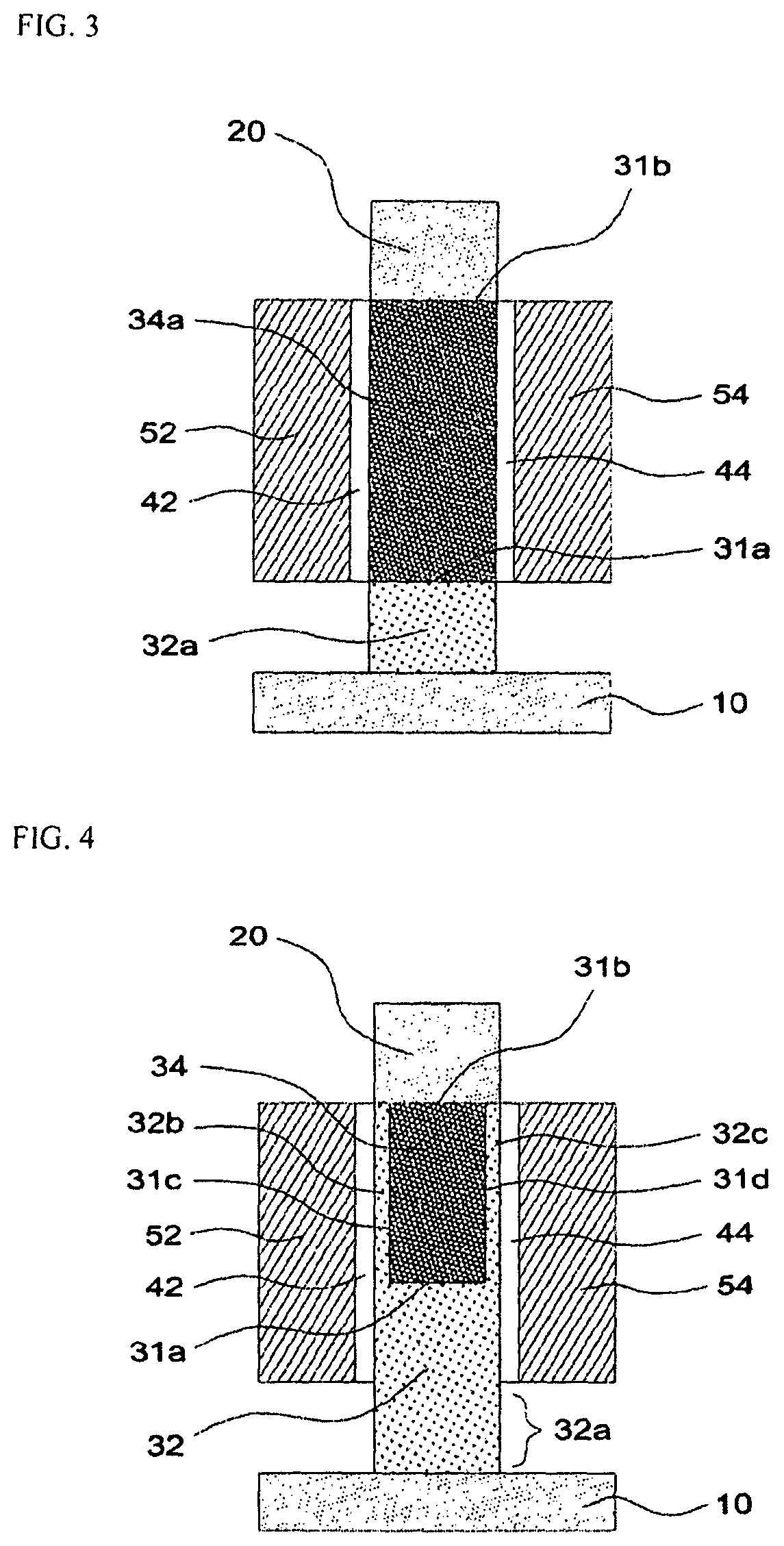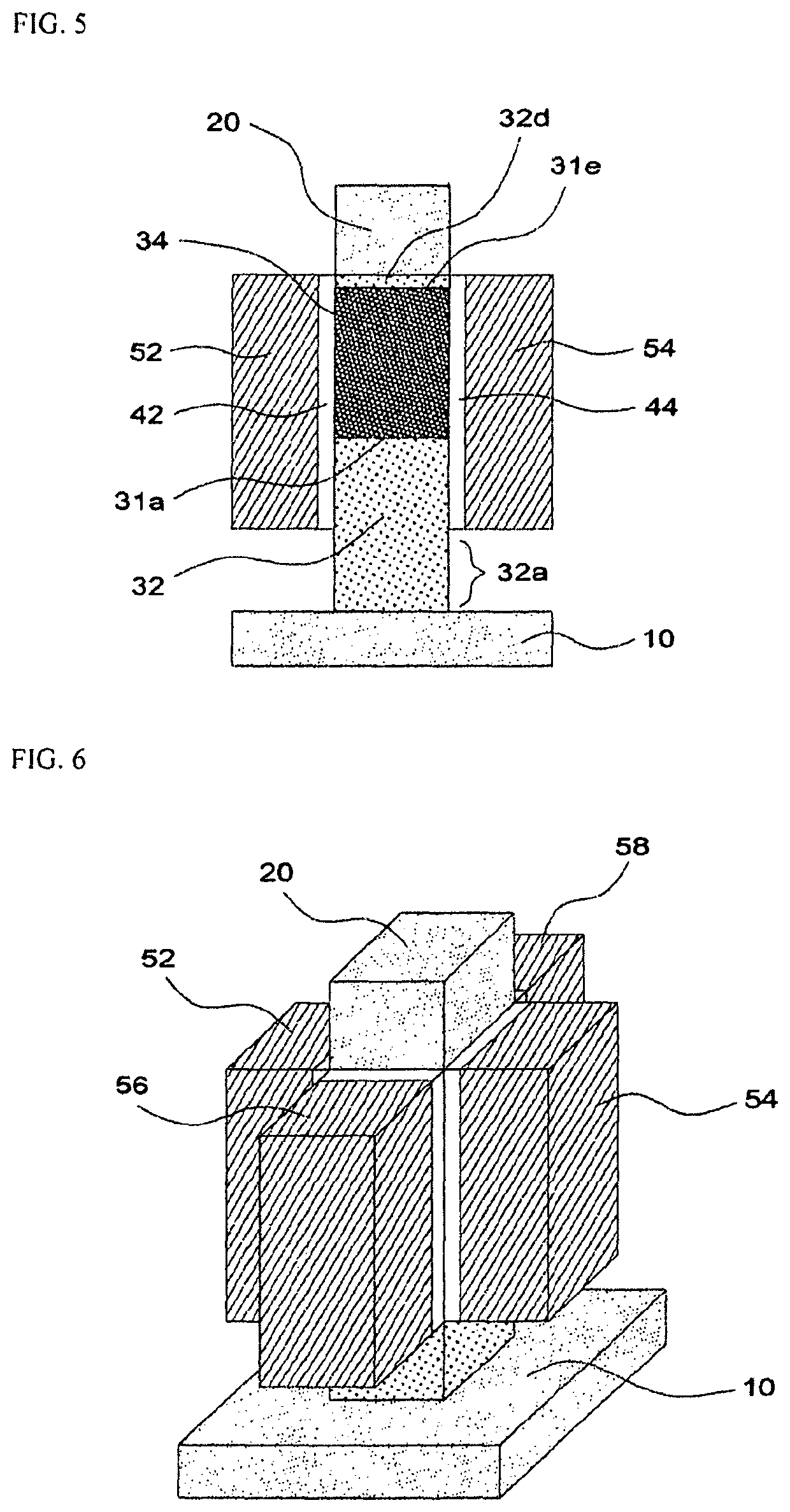One-transistor DRAM cell device having quantum well structure
a cell device and quantum well technology, applied in the field of one-transistor dynamic random access memory (1 t dram) cell devices, can solve the problems of capacitor scaling, large capacitor area occupied by the capacitor, capacitor scaling limitation, etc., and achieve the effect of reducing the area occupied by the device, increasing retention time, and limiting the channel length
- Summary
- Abstract
- Description
- Claims
- Application Information
AI Technical Summary
Benefits of technology
Problems solved by technology
Method used
Image
Examples
first embodiment
[0039]The 1T DRAM cell device according to the first embodiment of the present invention comprises, as shown in FIGS. 1 and 2, a body region 30 connecting a source region 10 and a drain region 20 and storing charge, and one or more gates 52 and 54 formed on the body region 30 with a gate insulating layer 42 or 44 interposed therebetween. Here, the body region 30 has a first semiconductor layer 32 and a second semiconductor layer 34 formed in a channel length direction with a first heterojunction surface 31a, and the first heterojunction surface 31a is perpendicular to the channel length direction.
[0040]The first semiconductor layer 32 may be formed of the same semiconductor material as that of the source region. It may have a homojunction with the source region 10. The second semiconductor layer 34 may be formed of a semiconductor material different from the drain region 20 to be in contact with a second heterojunction surface 31b perpendicular to the channel length direction.
[0041]...
second embodiment
[0067]The 1T DRAM cell device according to the second embodiment of the present invention comprises, as shown in FIG. 3, a body region 30 connecting a source region 10 and a drain region 20 and storing charge, and one or more gates 52 and 54 formed on the body region 30 with a gate insulating layer 42 or 44 interposed therebetween. Here, the body region 30 has a first semiconductor layer 32 and a second semiconductor layer 34 formed in a channel length direction with a first heterojunction surface 31a, and the first heterojunction surface 31a is perpendicular to the channel length direction. Two or more gates 52 and 54 are formed on the second semiconductor layer 34a at a position spaced apart from the source region 10 by the first semiconductor layer 32a.
[0068]The rest of the configuration and application examples are the same as those of the first embodiment described above.
third embodiment
[0069]The 1T DRAM cell device according to the third embodiment of the present invention comprises, as shown in FIG. 4, a body region 30 connecting a source region 10 and a drain region 20 and storing charge, and one or more gates 52 and 54 formed on the body region 30 with a gate insulating layer 42 or 44 interposed therebetween. The body region 30 has a first semiconductor layer 32 and a second semiconductor layer 34 formed in a channel length direction, the second semiconductor layer 34 being inserted in the first semiconductor layer 32 with a predetermined length from one side of the drain 20 in the channel length direction and having a first heterojunction surface 31a perpendicular to the channel length direction and one or more third heterojunction surfaces 31c and 31d parallel to the channel length direction. The second semiconductor layer 34 is formed of a semiconductor material different from the drain region 20 to be in contact with a second heterojunction surface 31b perp...
PUM
| Property | Measurement | Unit |
|---|---|---|
| energy band | aaaaa | aaaaa |
| time | aaaaa | aaaaa |
| dielectric constant | aaaaa | aaaaa |
Abstract
Description
Claims
Application Information
 Login to View More
Login to View More - R&D
- Intellectual Property
- Life Sciences
- Materials
- Tech Scout
- Unparalleled Data Quality
- Higher Quality Content
- 60% Fewer Hallucinations
Browse by: Latest US Patents, China's latest patents, Technical Efficacy Thesaurus, Application Domain, Technology Topic, Popular Technical Reports.
© 2025 PatSnap. All rights reserved.Legal|Privacy policy|Modern Slavery Act Transparency Statement|Sitemap|About US| Contact US: help@patsnap.com



